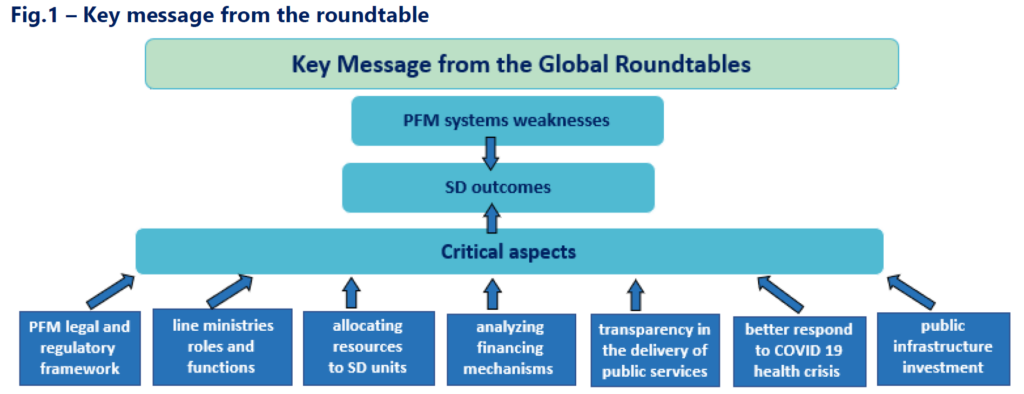
Around the world, there are major failings in the provision of core public services. PFM is expected to play a crucial role in the implementation of national and sectoral policies and ensuring more effective and efficient provision of public services. However, PFM is only one of many factors affecting the quality of public services delivered. It has been difficult to isolate PFM effects from broader institutional and public sector management issues impacting service delivery. Further, the COVID-19 pandemic crisis has significantly impacted Public Financial Management (PFM) systems, and their relationships with the Service Delivery.
With this background, the Public Expenditure and Financial Accountability (PEFA) Secretariat convened two Global Virtual Roundtables to explore key strategic issues on how to strengthen the links between PFM and service delivery in sectors on May 25 and 27, 2021. The roundtables brought together senior public finance and sector professionals from different organizations leading the work on PFM and sectors.
Three aspects of interaction between PFM and Service Delivery – (i) the importance of PFM for service delivery; (ii) expenditure efficiency; and (iii) what the PEFA program can do; were discussed at the two global roundtable brainstorming sessions. A short report was prepared by the PEFA Secretariat that summarizes the key discussions and emerging views. The key message from the global roundtables was that weaknesses in the PFM system can have significant consequences for the service delivery outcomes as outlined in Figure 1:
Participants agreed on the importance of deepening understanding of some critical aspects, including:
The PFM legal and regulatory framework for delivering public services. Are the powers and responsibilities of service delivery sectors and ministries adequately described in the country’s core PFM Act? Does the implementation of the law enable efficient service delivery in practice, and what modifications to the law would be appropriate?
The roles and functions of line ministries and associated agencies in delivering public services. A lot is known about PFM as a central function of public finance, including the role and functions of the central budget office (CBO), much less about the role and functions of line ministries and associated agencies in delivering these services. Questions raised at the roundtables included: What are the mechanisms used to deliver services such as health and education to end users, and how efficient and effective are they? What functions have been devolved to the ministries and agencies responsible for service delivery? How are the planning and finance functions structured in the service delivery departments and how are decisions on resource allocation made? What are the capacity gaps in terms of human resources and IT systems of these departments? Are there any international benchmarks of good performance? Much more research on these matters is required to provide clear answers.
All stages of the PFM cycle are important for efficient and effective service delivery, but especially the processes of allocating resources to service delivery units and executing these budgets. There are other challenges also. Cash resources can be constrained because of inadequate cash management by the CBO, or by inefficiencies in service delivery. Procurement can be a challenge, exacerbated by the relaxation of controls during the COVID crisis. Corruption may lead to waste and inefficient resource use, such as the accumulation of spending arears.
Financing mechanisms for the sectors vary wildly across countries and need to be carefully analyzed. The impact of the PFM system on resource mobilization depends on the methods and sources of financing service delivery. In cases where the public sector is significantly involved in service provision and financing, the sector will have a higher level of exposure to country-level PFM rules than a system where the government is neither the major provider nor financier of the services (e.g., health services in many countries).
The COVID-19 health crisis has highlighted the need for more transparency in the delivery of public services, especially related to health, the importance of internal controls and “keeping the receipts”, and strong internal and external audit. Such provisions are required to balance the relaxation of various PFM regulations during the crisis – for example: streamlined public procurement rules, more flexible execution of budgets, simplified payment processes, bypassing of parliamentary oversight. More timely audits of emergency spending have been useful in some countries to enhance transparency and rebuild public trust in the accountability of public officials.
How have PFM functions in service delivery departments been adjusted to better respond to the COVID-19 health crisis? Some countries have established COVID funds for delivering health services, transfers to needy households, etc. How effective have these arrangements been? Will they be retained after the COVID health crisis as permanent institutions?
Some countries have already increased public infrastructure investment to boost their economies as part of the post-crisis recovery. Such investment projects include many key service delivery sectors (e.g., hospitals, health centers, schools, water and sewerage systems, drainage, and irrigation, etc.). This will require effective PIM institutions at the center of government and in-service delivery agencies to plan and allocate resources for investment, undertake appraisals, and implement selected projects.
Read the paper “Strengthening the Links between PFM and Service Delivery in Sectors” with the key messages from the two Global Virtual Roundtables organized by the PEFA Secretariat on May 25 and 27, 2021:
https://www.pefa.org/resources/strengthening-links-between-pfm-and-service-delivery-sectors




